Outboards power ahead
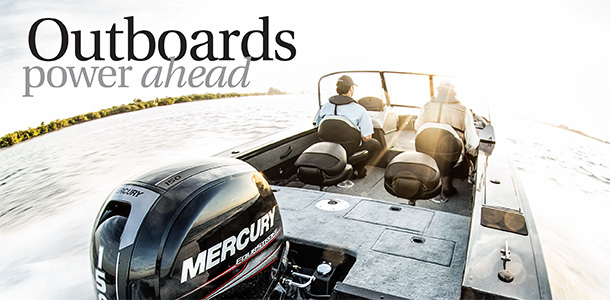
New tech, simplicity keep outboard market growing
It’s no secret that over the last several years, outboards have been leading the industry recovery.
As the marine industry slowly improves, the sales gap between sterndrives and outboards has continued to grow. Outboard-powered boats continued to lead the way in 2013, with sales up 8.8 percent through September, compared with a 7.8 percent decline in sterndrive unit sales, according to Info-Link.
Over the last several months, sterndrive manufacturers have announced new initiatives that should help to boost that part of the industry. At the same time, outboard makers say their continued innovation and ease of use will keep that segment strong as well.
A large portion of the industry agrees as well, as shown by our latest reader survey, where 77 percent said they expect an increase in outboard sales this year – and only 5 percent expect a decrease. (Read more from the survey here.)
New product, new business
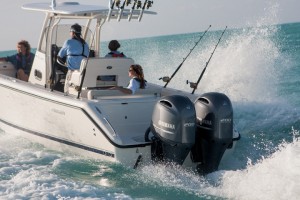 The wave of new products in the last couple years has reinvigorated the outboard segment, manufacturers say, by bringing the experienced boaters back into the marketplace.
The wave of new products in the last couple years has reinvigorated the outboard segment, manufacturers say, by bringing the experienced boaters back into the marketplace.
“The serious boater… is stepping back into the market,” said Dean Burnett, vice president with Yamaha’s Marine Group. “What he’s looking for is something better than what he has. We see that guy is staying in the same horsepower in most cases that he is today. What he wants is something new.”
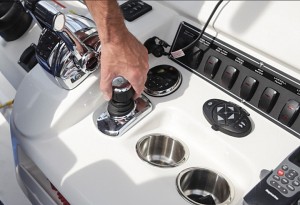
Yamaha rolled out several new engines over the last year, led by the F200, a four-cylinder four-stroke engine that weighs in at 487 lbs., 119 lbs. lighter than its predecessor. The F200 is available with digital electronic control or mechanical control.
“The 200 was all plus business for us, it was remarkable for us,” Burnett said. “We figured it would eat into other things we sold, like the four-cylinder 150. We sold more 150s [in 2013] than 2012.”
The F200, and the new VMAX SHO 150, both won innovation awards at the 2013 IBEX show.
With the success of the 200, Yamaha will be introducing a new 115 and a 175 in the first quarter of this year, both lighter and quieter than the previous models.
“That type of technology and plus-one from a feature standpoint is what people are looking for,” Burnett said. “People want new, they want higher-tech.”
The flexibility of outboards fits that trend well, making it easy to repower without extensive work.
“One of the big advantages of outboards is that they are a very flexible form of propulsion and we design them to be applicable to a whole range of boat categories,” said Dave Foulkes, vice president of engineering at Mercury Marine.
With the continued acceptance of four-stroke technology, further refinement and improved fuel economy, there are many reasons buyers are choosing to upgrade their outboards, Foulkes said.
That trend is reflected in the success of Mercury’s new 150 hp FourStroke.
“I think there’s a good trend toward improved reliability and service,” Foulkes said. “It’s very ‘torquey,’ very refined and quiet, it’s very light. The aesthetics and craftsmanship are very strong as well, a nice overall package for a whole range of applications.”
There is ever-increasing demand for lighter engines and better fuel economy from consumers and that is driving a lot of the improvements in today’s outboards from improved materials to fuel injection and control systems.
“If the engine is lighter, the boat rides better,” said Gus Blakely, manager of sales planning and development at Suzuki Motor of America. “Now we’re looking at second- and third-generation four-stroke engines that weigh less than the two-strokes that used to be out there.”
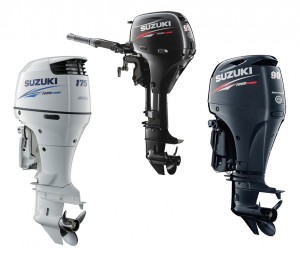
In December, Suzuki introduced the new DF30A and DF25A. The engines are the lightest in their class, and also feature fuel injection, giving Suzuki a full lineup from 9.9 to 300 hp four-stroke, fuel injection models. Being the lightest in a given class is always the goal when Suzuki releases a new model, Blakely said.
Fuel injection allows the company the ability to better control fuel use. Lean Burn Control, Suzuki’s intelligent fuel management system, predicts fuel needs by monitoring the engine performance and operating conditions. It can then deliver a leaner fuel mixture at times, improving fuel economy.
“We can reduce the fuel and at the same time we’re doing this with no loss of performance or operating conditions that the customer would be unhappy with,” Blakely said. “It’s better for the environment … and delivers value for our customers. He can use the product longer and it costs him less money to do so.”
With the continued growth of the pontoon segment, there has been increased demand for products that meet the specific needs of that market. The larger luxury pontoons of today require more power to move and maneuver in close quarters.
At Yamaha, the numbers go back and forth weekly between what is selling best – engines for pontoons or bass boats, Burnett said, a major shift from the past.
That need prompted the release of Suzuki’s DF50AV and DF60AV high-energy rotation models.
“We’ve taken a modified 115/140 gear case, made some changes and added that to the 60 and 50,” Blakely said. “The new 50 and 60 models allow us to turn that larger propeller, helps us control that boat, gets it up and going faster. It gives our customer a better operation and a better ride.”
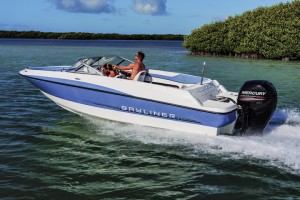
The new lower unit on the 50 and 60 has a 2.42:1 gear ratio and 14-inch propeller. In Suzuki’s testing, the DF60AV delivered a 42 percent improvement in forward thrust and 136 percent improvement in reverse thrust compared to Suzuki’s standard DF60A outboard.
Joystick tech
One of the big pushes in the industry last year was the spread of joystick technology by multiple companies on their outboard products. While thus far still a niche product, the manufacturers are pleased with its initial reception.
“We know that new technology like this … it’s going to be a slow burn,” Burnett said, of Yamaha’s Helm Master. “We know that people want this technology. We’ve sold hundreds of these things into the field. The people that have it are thrilled with the product.”
The system is designed to make operation in close quarters simpler and less stressful, but Burnett is quick to point out that the joystick control is only one aspect of Helm Master.
“It is a high-tech computer system, a fully integrated boat control system,” Burnett said. “All the other features of it is what people are really starting to grab ahold of. The joystick aspect of it is that ‘a-ha’ moment at the dock.”
Those other components include a new electronic steering system, electronic key system, anti-theft devices, display units and more.
“We’re going to continue to build on it,” Burnett said. “There’s more stuff coming.”
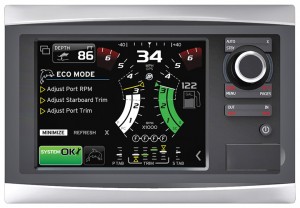
The success of the Axius joystick technology in its sterndrive engines has Mercury optimistic about its market penetration in outboards, Foulkes said.
“Once you’ve experienced the technology, especially if you’re more on the new boater side, it’s difficult to get away from it,” he said. “Even for experienced boaters, the ability to do GPS station keeping, whether its for convenience … or for keeping position over a wreck or whatever the applications might be, the technology sells itself very, very well.”
The goal is to make joystick piloting a seamless experience for the user by integrating with the full offering of Mercury electronics and software, such as VesselView, the Skyhook digital anchor and integrated autopilot.
“That kind of system that takes something that can be very complicated to operate like a multi-engine outboard boat and transforms it into something that is much easier to operate,” Foulkes said. “I think that joystick piloting as applied to outboards … really makes a huge improvement in that boaters can concentrate on what they’d like to be doing as opposed to getting nervous and frustrated about some of those aspects of boating.”
Suzuki has also embraced joystick technology, offering Suzuki Precision Maneuvering early this year on models equipped with Suzuki Precision Control, currently 150, 175, 250 and 300 hp models. The company will be showcasing the technology at this year’s Miami International Boat Show.
“We feel like that’s another area where you’re going to see a technology shift from standard cable control to electronic controls,” Blakely said. “It’s easier for the boat companies and installation. Don’t have the wear and tear of cables, get a real positive shift, positive neutral. We think that’s the future.”
By allowing aging boaters and those intimidated by maneuvering larger boats to take on the challenge, the technology should help to expand the pastime.
“My hope is that joystick control will appeal to a lot of younger people,” Blakely said. “It just really makes it easy to operate a boat.”
While not ready to release pricing information at press time, Blakely said Suzuki expects to have its system “at a more reasonable price” than other current offerings.
“Over time, like any technology, I think you’ll see the price come down,” he added.
Future focused
We can expect to see continued focus on weight reduction, propeller improvements and fuel economy, along with more technology, Blakely said.
The integration of technology will only speed up, Burnett said.
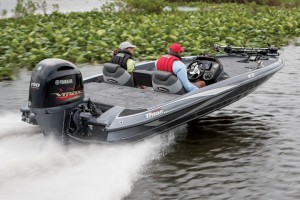
Yamaha is looking at features such as the as the ability to read computers on engines remotely or the ability to communicate directly with service shops or the consumer via wireless communication.
“That technology exists today and when we get questions from consumers those are the kinds of questions we’re getting,” Burnett said. “The marine industry generally lags behind the automotive industry in technology, but we’re all looking at it. The economies of scale make it a slower transition.”
The “How big can we get?” question will also continue to be a prominent one.
“What’s next after 350? We’re looking at product plans through 2020 right now that will hopefully answer those questions going forward,” Burnett said. “We’ll continue to look at products that are lighter weight, better horsepower.”
Foulkes agreed, saying the question is if there is a “logical upper limit” to outboard power.
“Is it better to have more outboards on the back of the boat or fewer, more powerful outboards on the back of the boat? And where’s the right break point?” he said. “As they become very large, the outboards tend to become somewhat unwieldy and very expensive. On the other hand, people want more and more power on the back of the boat.”






About the DF60AV – we pruchased one, and it fails to push the same skiff that we previously had a 40 hp yamaha on. It appears it is only lugging, struggling to turn that larger lower unit. Perhaps the pitch of propeller is wrong, and we would like suggestions. We tried the 19 and 17 pitch, and each does not push the skiff as well as the 40 hp yamaha.